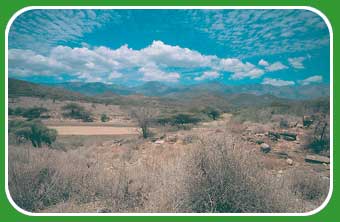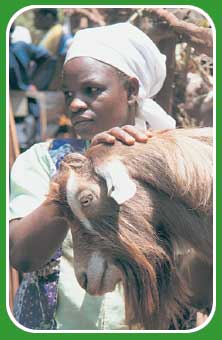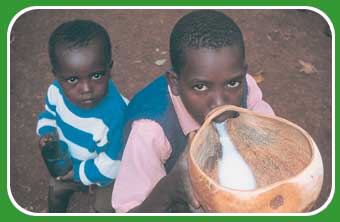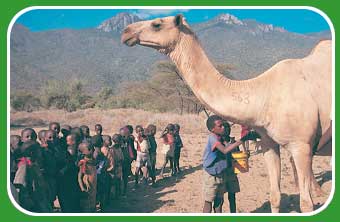| � |
In parts of sub-Saharan
Africa, food production has fallen by 23% over the last 25
years, and one in three people are chronically undernourished.
Yet sustainable solutions are making a difference to people
across the region.
 for an activity that looks at different sustainable ways to
improve food security and reduce the risk of land degradation
in sub-Saharan Africa. You will need FLASH
to complete this activity.
for an activity that looks at different sustainable ways to
improve food security and reduce the risk of land degradation
in sub-Saharan Africa. You will need FLASH
to complete this activity.
Living on the Edge
Many people lead a precarious existence south of the Sahara.
With local knowledge, they have learned to make the most of
the resources available and to be flexible as conditions change.
But for three years in a row, the rains have failed and by
2000 the threat of famine was looming again.
| Annual
rainfall is always unpredictable in this dryland environment.
Population pressure has added to the problem of prolonged
drought. On the highland plateau of Ethiopia, the population
has nearly doubled since 1984, the year of the worst famine
of the region. With few ways to earn a living other than
farming, pressure on the land is immense. Farm sizes are
shrinking, and the soil is over-used. |

�Dominic Harcourt-Webster/FARM
Africa. |

John Barnes, ex-Liverpool and England footballer joined Save
The Children in a trip to Wollo province, Ethiopia in February
2001 to discover how Save The Children is helping to improve
the lives of people there.
 to
find out more. to
find out more.
The future looks bleak
too. Climate change may make droughts more common and more
extreme in the region, and if the number of HIV/AIDS victims
continues to rise, there will be less people who can grow
food.

FARM Africa is a charity that works to reduce poverty and
help poor African farmers to make sustainable improvements
to the way they use the land. To find out more about FARM
Africa, and how you can support their work, visit www.farmafrica.org.uk
A new type of Goat
In the rural district of Meru in Central Province, Kenya,
FARM Africa has been working with local people to improve
their food security with goats. Goats are cheaper and much
easier to care for than cattle. Goats are also part of the
culture and background experience of the Meru people. Local
goats didn't produce much milk, but after they were cross-bred
with a breed of British goat, each animal could produce 3
litres a day, four times more than before.
 �Dominic
Harcourt-Webster/FARM Africa.
�Dominic
Harcourt-Webster/FARM Africa.
|
Since
the start of the project, 6,000 cross-bred goats have
been born.In
addition, farmers can sell their surplus milk and goat
products to buy other foodstuffs, and to pay for their
children's schooling or their medical bills. The plentiful
supply of goat manure has helped to fertilise vegetable
and fruit gardens too.
|
| The
immediate benefit is that the community's diet and health
improves. Goat milk helps the children to grow strong. |
 �Dominic
Harcourt-Webster/FARM Africa
�Dominic
Harcourt-Webster/FARM Africa |
Goats as Scapegoats

To keep the goats healthy, FARM Africa have trained men and
women farmers to carry out basic vet work themselves. For
the more serious cases, FARM Africa has paid for two vets,
who use motorbikes to visit farmers in outlying parts of Meru.
In return, farmers can alert the vets to any health problems
that are affecting their animals, including outbreaks of foot
and mouth disease.
A Switch to Camels
Further north where the environment is even more dry and harsh,
FARM Africa has been supporting the Samburu people of Kurungu
village. The Samburu traditionally reared cattle but the prolonged
drought has repeatedly wiped out their livestock.

�Dominic Harcourt-Webster/FARM
Africa |
The
introduction of camels suited the natural conditions and
needs of the Samburu people.
|

�Pieternella Pieters/FARM
Africa |
Like the goats in
Meru, the camels open up new opportunities for trade.
Also, camels are more resilient in times of drought and
their milk is an important source of vitamin A, which
is hard to find in other local foods. Every two weeks,
the children of Murungu village are taught how to look
after the camels. They are given lessons in milking, recognising
common diseases and checking for ticks and worms. This
way, it is hoped that they will become an established
part of Samburu life as the children grow up. |
Building on Experience
FARM Africa's projects build on local knowledge and involve
local people in decision-making. This way, the projects give
local people a sense of ownership, and help people help themselves.
As a result, FARM Africa's projects are more likely to be sustainable
as the benefits can continue long after FARM Africa's involvement
ends. Greater local participation in decision-making is now
recognised as a successful way of planning for the future in
developed countries as well.
Even though the rewards may be small and a long time coming,
thousands of farmers have been lifted out of extreme poverty
as a result of the projects in Meru and Kurungu village. Nevertheless,
they are only small islands of success in a region where poverty
and hunger remain a widespread problem. |
� |





